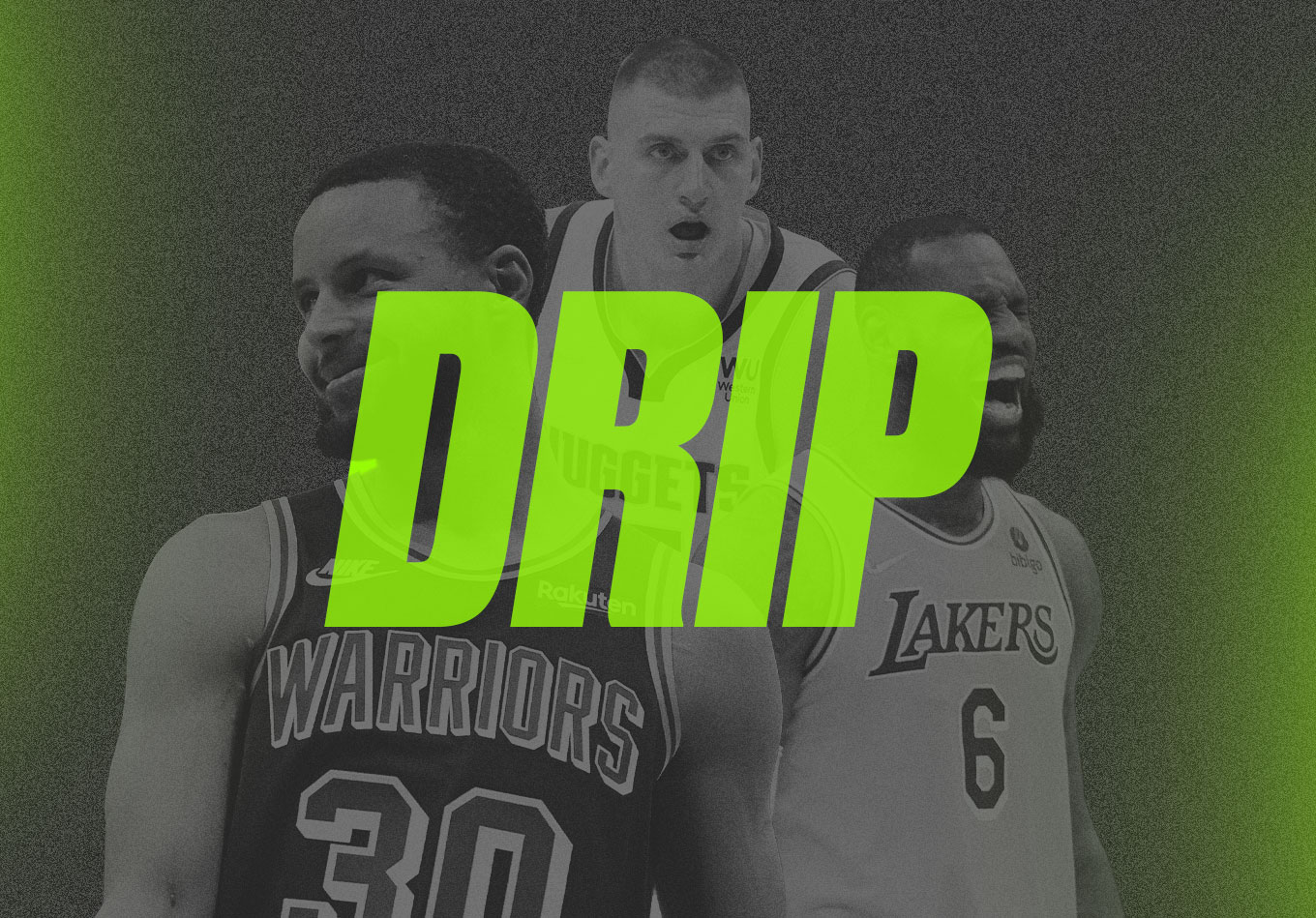The All-Star break is upon us and the best players of the “first half” of the season will be honored on Sunday night.
But, since the All-Star break is actually about 70% of the way through the season, the remainder of the schedule will be a sprint instead of a marathon. Each team has less than 30 games to determine its postseason fate, and a lot will hinge on the best individual performers of the last part of the season.
To project which players will be the best for the remainder of the season, we turn to DRIP. Since DRIP is a projection system based on previous performance, we can inform the future by looking at the past. We know who the first-half All-Stars are, but who will be the second?
Let’s find out, by checking the top backcourt and frontcourt players (according to DRIP) who have logged at least 1,200 minutes so far this season.
We used box position to sort which players are in the backcourt and which are in the frontcourt. Box position takes into account what a player does on the court and assigns them a ranking from 1-100, with 1 being a true point guard and 100 being a true center.
Anyone 50 and under was considered a backcourt player here, while anyone over 50 was considered a frontcourt player.
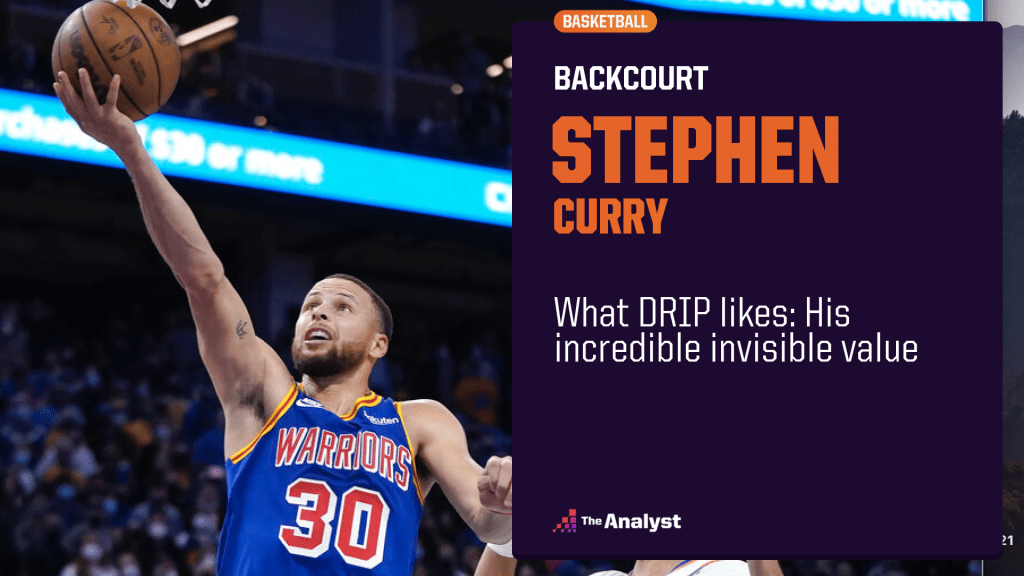
It hasn’t been the best shooting season for Stephen Curry, who has never shot under 41.0% on 3-pointers in a full season in his NBA career, and currently sits at 37.9%. (There aren’t many players who could shoot around 38% on 3s in a down year but Curry is one of one.)
But Curry’s still ranked first in DRIP and his projection is aided by his incredibly high floor due to his Jupiter-like gravity.
Basically, what will always keep Curry highly ranked in almost any projection system is his team’s ability to utilize his lethal shooting even when he never touches the ball. No matter what kind of slump he is in, defenders will never, ever, ever leave Curry open. His quick trigger and unlimited range mean his primary defender needs to stay as attached to him as possible.
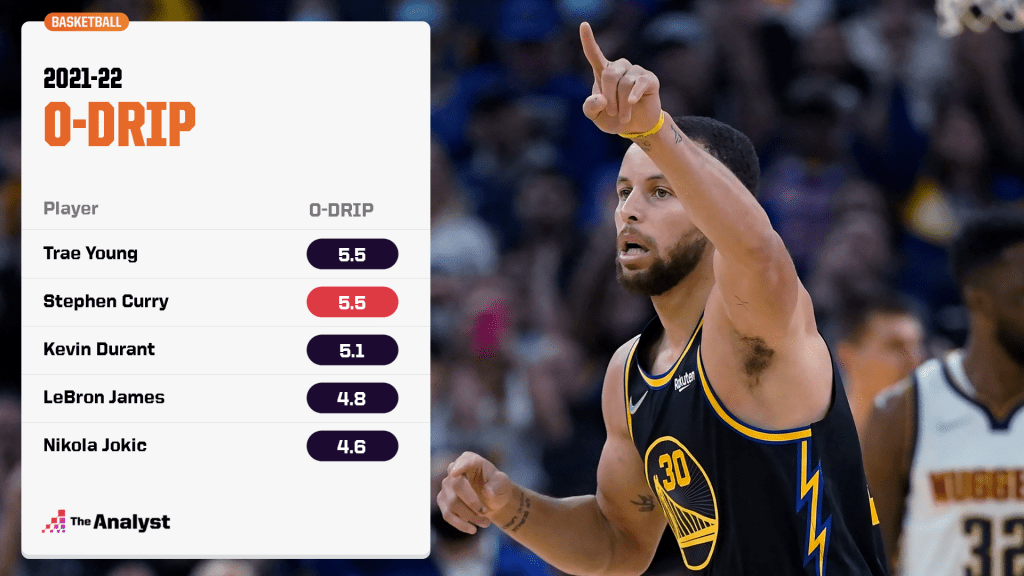
Curry knows this and is willing to engage in off-the-ball action more than almost any superstar in the league. He runs through picks at full speed like guys who are just shooting specialists, and sets excellent picks for a player his size. He’s also an excellent and willing passer when he needs to defer. Defenders are more fearful of Curry getting an open jump shot than any other player in the league, and this allows other players on his team to get more open.
And this type of activity is basically slump-proof. No matter how poorly Curry shoots, his value to the offense with his gravity won’t change as long as defenders are terrified of him.
DRIP projects him as the second-best offensive player (O-DRIP) the rest of the season behind Trae Young, and, unlike Young, Curry is a solid team defender. Even without his best shooting season, Curry is still incredibly valuable.
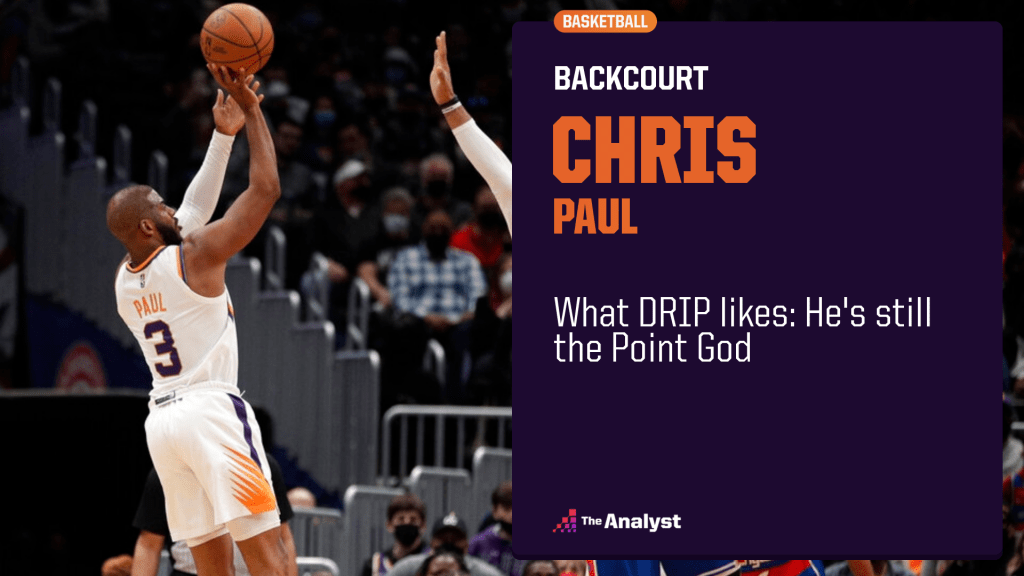
Small guards have historically not aged well, but Chris Paul is fine wine.
He is maestro on both ends of the floor. No one dictates the flow of the game like Paul, and his fingerprints are all over the incredible year the Phoenix Suns are having. Phoenix is the only team in the league in the top five in offensive and defensive efficiency, and, not coincidentally, Paul is the only player in the top 15 in both offensive and defensive DRIP (D-DRIP).
Paul leads the league in assists by half an assist per game, and DRIP sees that continuing as he’s projected to have the most assists per 100 possessions. DRIP also projects Paul to have the fifth-most steals per game, something he achieves without ever gambling at the wrong time.
If Paul keeps playing at the level DRIP expects him to, he’ll be an excellent position to get his first title this year.
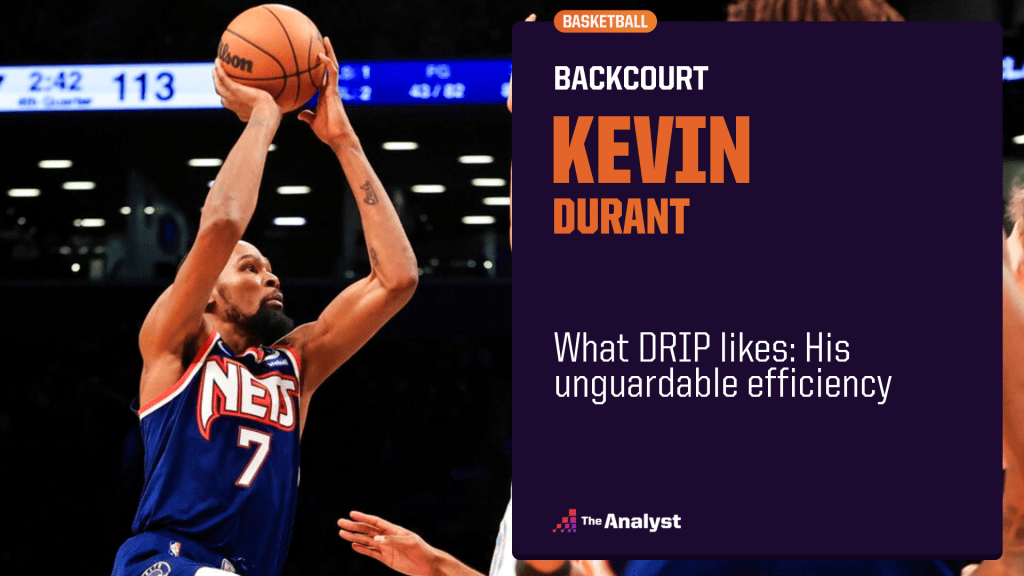
It may be surprising to see Kevin Durant listed as a backcourt player, but he qualifies with a 45 box position. It’s certainly not surprising to see him on this list overall, as his value has been very apparent in his absence.
Before he got hurt, the Brooklyn Nets looked like a contender for the top seed in the Eastern Conference. But when he returns, he’s going to have to fight to keep his team out of the bottom half of the play-in picture.
Durant’s defense has slipped a bit this year and DRIP projects him as the second-worst defender among the top-six guards in total DRIP. But his offense more than makes up for it, as he projects to be the third-best offensive player in the league the rest of the year.
Out of players projected in the top 15 in usage rate, Durant is expected to have the third-highest true-shooting percentage over the rest of the season. Though he’ll likely handle an even bigger offensive responsibility when he comes back, Durant is able to do so without sacrificing efficiency when he has to score at a high volume.
DRIP isn’t a doctor, but, if he comes back healthy, Durant will retake his place in the conversation about the best player in the league.
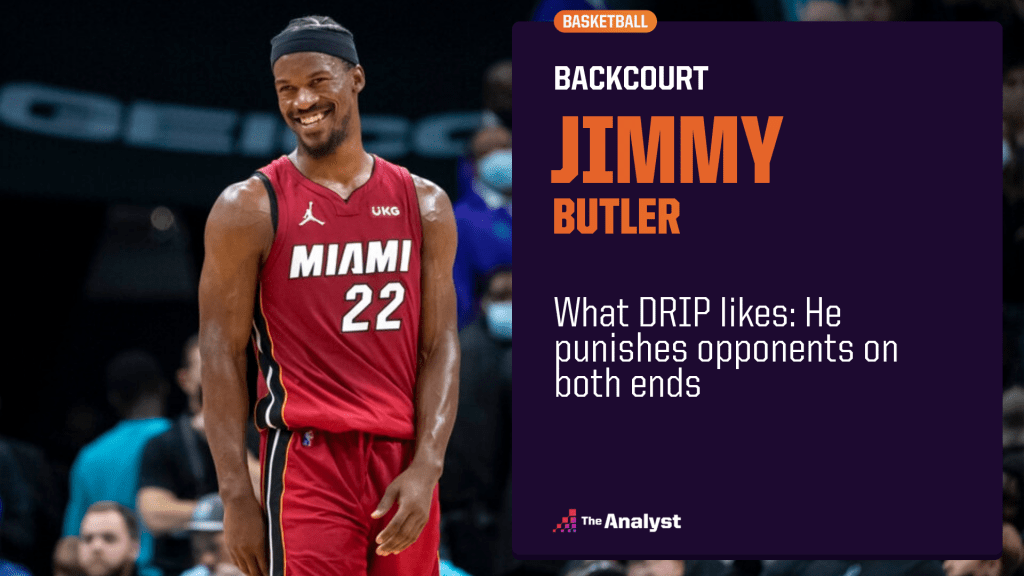
There are few players who embody their team better than Jimmy Butler. The Miami Heat are a resilient team that punches their opponents in the mouth and they’ve withstood a ton of injuries to move atop the Eastern Conference.
This resiliency starts with Butler, who is a bulldog on both ends of the floor. Opponents know they are in for a battle on every possession with Butler, who finds himself getting to the foul line as much as almost any player in the league.
It’s impressive that DRIP projects Butler to have the second-highest free-throw rate in the league behind only Charlotte Hornets center Mason Plumlee. And teams foul Plumlee intentionally quite often because he’s shooting 36.8% on free throws this season.
Butler doesn’t get the same kind of free passes; he’s simply stronger and more relentless than the people guarding him. He embraces contact and opponents know if they don’t push him off his spots, he’ll smoke them.
The biggest question for Butler is if he can stay on the floor. After missing 20 games last season, he’s already missed another 20 this year. Miami has been incredible even when missing Bam Adebayo or Butler, but for a trip back to the Finals, the team needs their stars healthy.
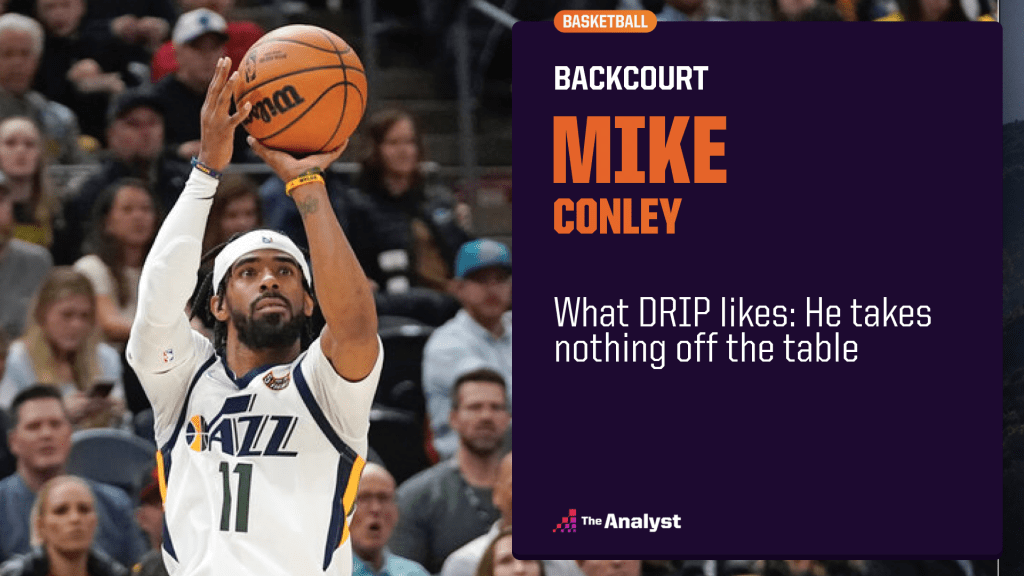
Mike Conley is by far the most surprising name on this list, as he’s not considered in the same echelon of players as the other stars.
But even if you think Conley fairs too well in this and other models, there’s no denying that he is an impactful player. And his game is the kind that projection systems will always reward, because instead of doing one thing extremely well, Conley does everything at a passable rate.
There aren’t a lot of individual projections that pop off the page for Conley. He projects have the 12th-most assists per 100 possessions and the eighth-most steals the rest of the year, neither of which are surprising. DRIP doesn’t project a radically different role for him, or see any of his percentages shooting up, although he will continue to be a very good shooter.
But DRIP sees Conley as one of the most balanced players in the league, pinning him with the 20th-best offensive projection and 13th-best defensive projection.
While the Utah Jazz still need better wing defense to reach their full potential in the playoffs, Conley’s elite play at the point of attack meshes nicely with perennial NBA Defensive Player of the Year candidate Rudy Gobert in the middle. Even with Gobert missing a decent chunk of games, Utah’s defense is ninth in efficiency this season and Conley’s play has been a big reason why.
Offensively, Utah has been the best team in the league – more than a point better per 100 possessions over the second-place Atlanta Hawks. Conley may not be the high-level scorer the other players on this list are, but his versatility and ability to make the right play are a perfect fit for the Jazz.
He may not be the engine, but he’s the synthetic oil that allows the engine to run at its best.
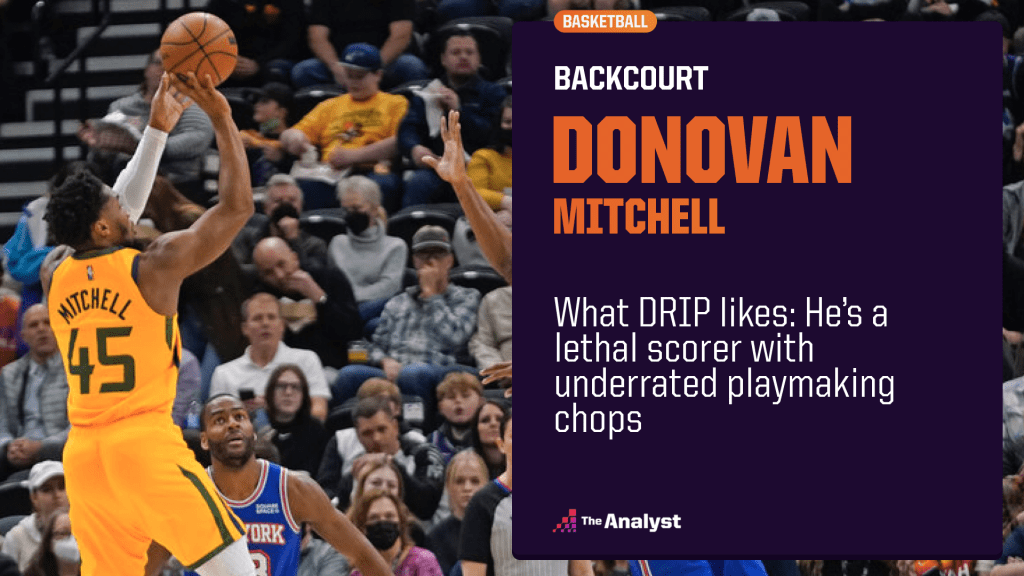
Conley’s backcourt mate finds himself as one of the most valuable guards in the league as well. And he is the offensive engine for the best offense in the league.
Donovan Mitchell hasn’t shot the ball well from behind the arc this season, shooting only 35.1% on 3s – down from 38.6% last year. But he’s managed to overcome that by upping his percentage on 2-point shots from 47.6% last year to an impressive 54.8% this year. So, even with the worse jump shooting, his true shooting percentage has improved.
It’s also time to recognize Mitchell as a true playmaker at the shooting guard spot. He’s averaging 5.2 assists per game – identical to his number last year – and always willing to leverage the defensive attention on him into a better shot for his teammates.
Mitchell may not be seen as the offensive hub as some of his peers, but he’s sixth in usage among players who have played 1,200 minutes. He’s been a high-usage player for the best offense in the league and deserves a ton of credit for that.
DRIP is not nearly as optimistic on the other side of the ball, however. Mitchell projects to be the worst defender among the top-six guards by far, as he has the 106th-best defensive projection for the rest of the season.
Mitchell has been part of the problem for the Jazz when the defense has gone sideways, and he’ll need to beat his defensive projection for Utah to take the next step on that side of the ball.
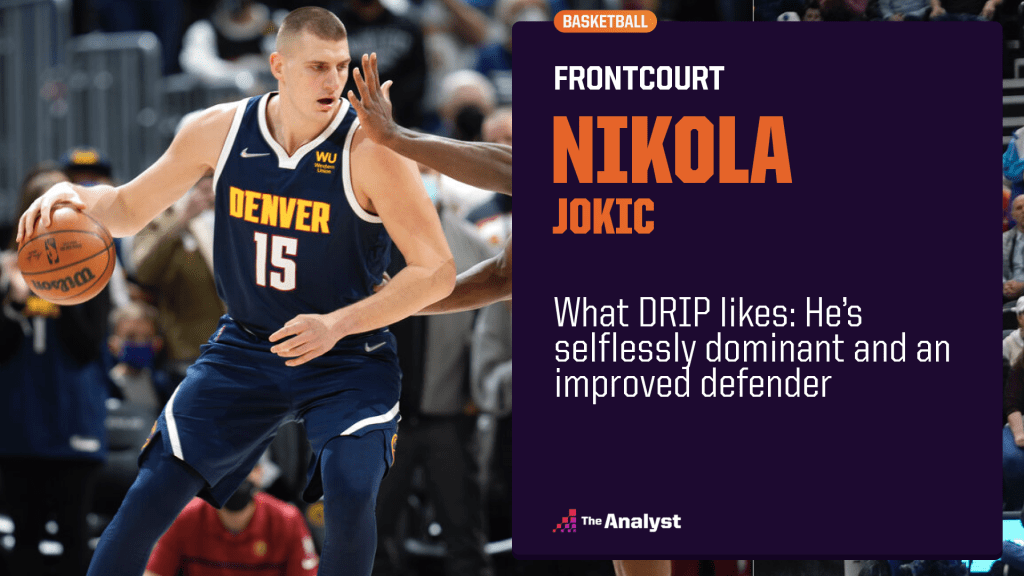
It was hard to imagine Nikola Jokic improving after an MVP season, but he’s done just that.
On offense, Jokic is still one of the most dynamic players in the league, projected to rank in the top five in true shooting percentage, points per 100 possessions and assists per 100 possessions. He’s the best passing big man the game has ever seen and he’s become willing to dominate one-on-one matchups with his scoring ability the last couple of seasons.
It’s defensively that Jokic has taken his game to a new level. He’s more mobile and communicative than ever and has gone from a liability to an asset. While he may not have the defensive impact of some of the best two-way weapons in the league, he projects to be the 28th-best defender in the league the rest of the season.
Not bad for a player who was seen as a weak defender for most of his career.
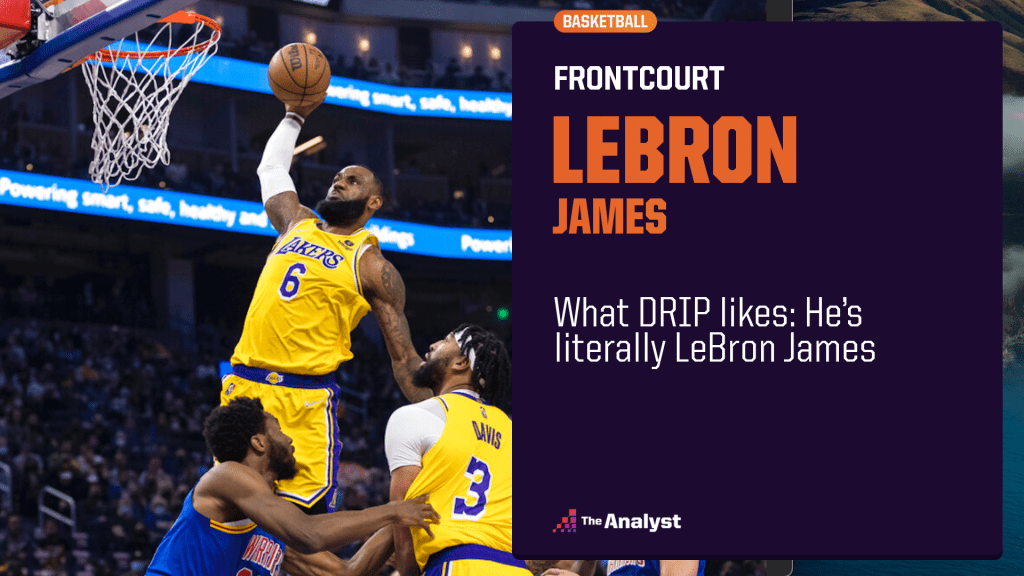
It’s been a long time since LeBron James wasn’t on a list of the projected best players, and even injury and team disappointment couldn’t keep him off this list.
James isn’t the everyday force on defense he used to be and DRIP acknowledges that, projecting him as the 42nd-best defender in the league. But he can still be a weapon for possessions at a time on that end and his versatility has been key for the Los Angeles Lakers, as the team has been forced to use him at center at times.
Offensively, James is still a top-five player in the league, according to DRIP. He combines elite size, scoring and playmaking, while his shooting has improved as he’s aged. Even though his 3-point percentage is down a bit to 35.3%, he’s increased his attempts to 7.9 per game, which is 1.6 above his career-high.
All the 3-point shots may be an indicator that James can’t go to the rim as often as he used to, but he is obviously still a force. Even if the Lakers nightmare season continues, a healthy James is still one of the best players in the league.
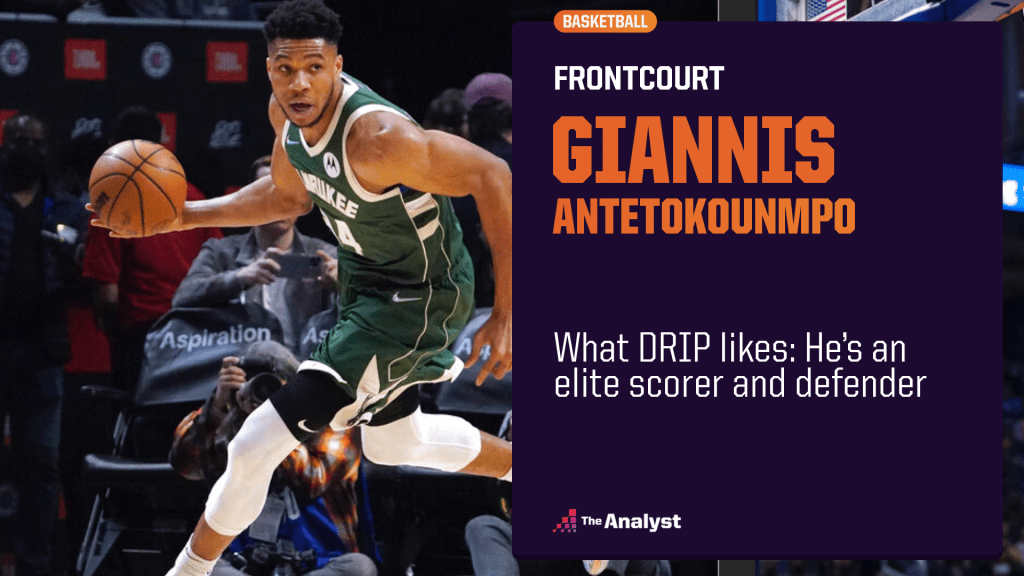
Paul’s elite play on both ends was highlighted earlier and the only one who comes close to matching him, according to DRIP, is reigning Finals MVP Giannis Antetokounmpo.
He’s ranked 16th in O-DRIP and fourth in D-DRIP, which highlights what a difference-maker he is on both sides of the ball.
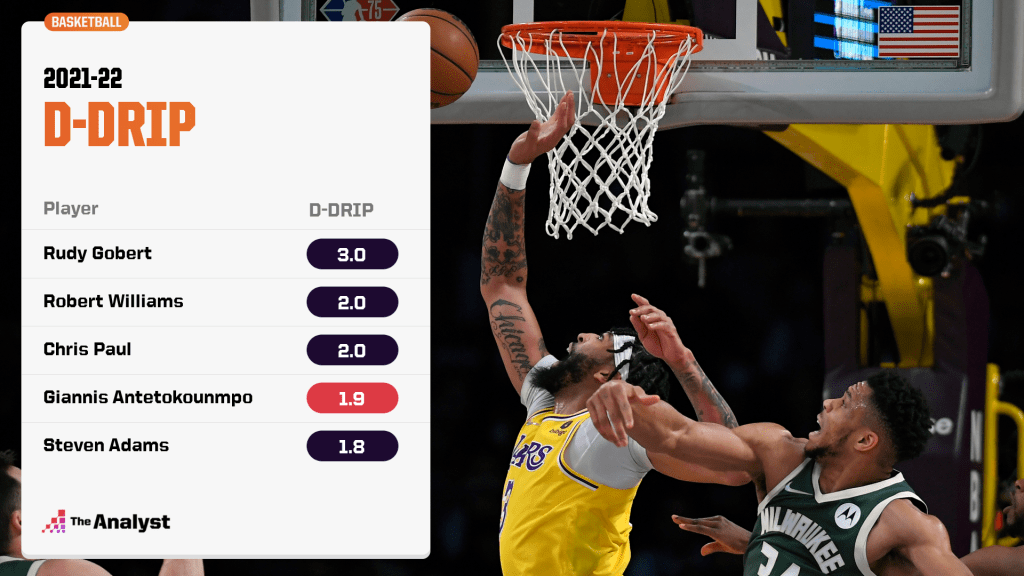
The Milwaukee Bucks haven’t hit their stride as the dominant force in the East that many expected them to be, but with Antetokounmpo and two other players DRIP is high on in Khris Middleton and Jrue Holiday, it might just be a matter of time.
Antetokounmpo is unstoppable near the basket on offense and the scariest help defender in the league on the other end. He projects in the top 10 in points, rebounds and assists per 100 possessions as well as usage rate.
The playoffs last season cemented him as one of the best players in the game and DRIP agrees with that assessment.
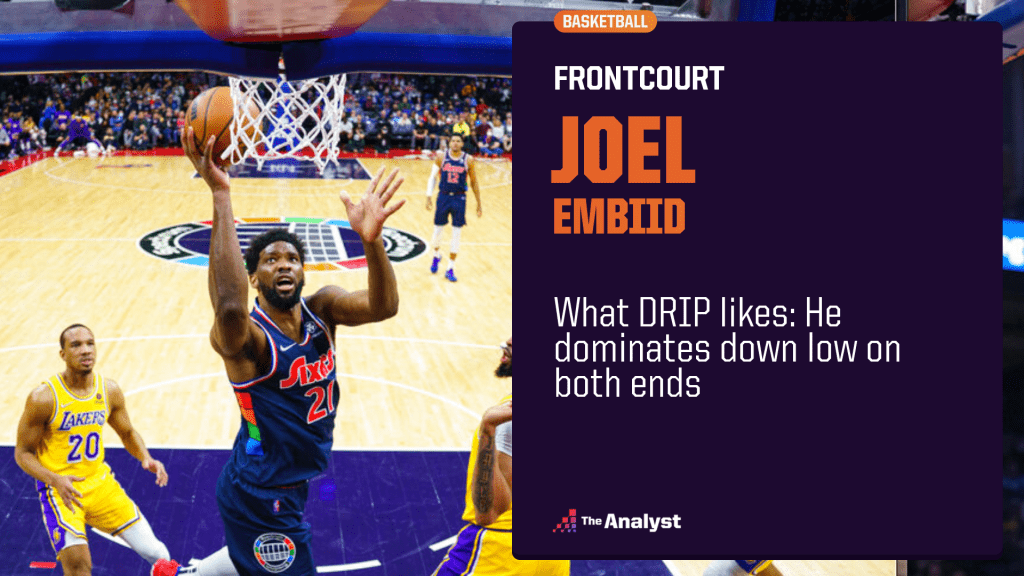
One of the MVP favorites, Joel Embiid now finds himself on a team with James Harden. That pairing is obviously one to watch and is talented enough to propel the Philadelphia 76ers to the Finals if they can reach their ceiling together.
Embiid is projected to have the second-highest usage the rest of the season, but that will likely go down when Harden returns from injury. But Harden showed last season when he was traded that he was willing to defer when he needed to and he’s never played with a post-player like Embiid.
While he’s projected to be a solid offensive player the rest of the year and is unstoppable when he gets the ball near the rim, defense is still the more dominant end for Embiid. He projects as the ninth-best defender, buoyed by his defensive rebounding ability (projected to have the third-most defensive rebounds per 100 possessions) and his shot-blocking prowess (projected for the ninth-most blocks).
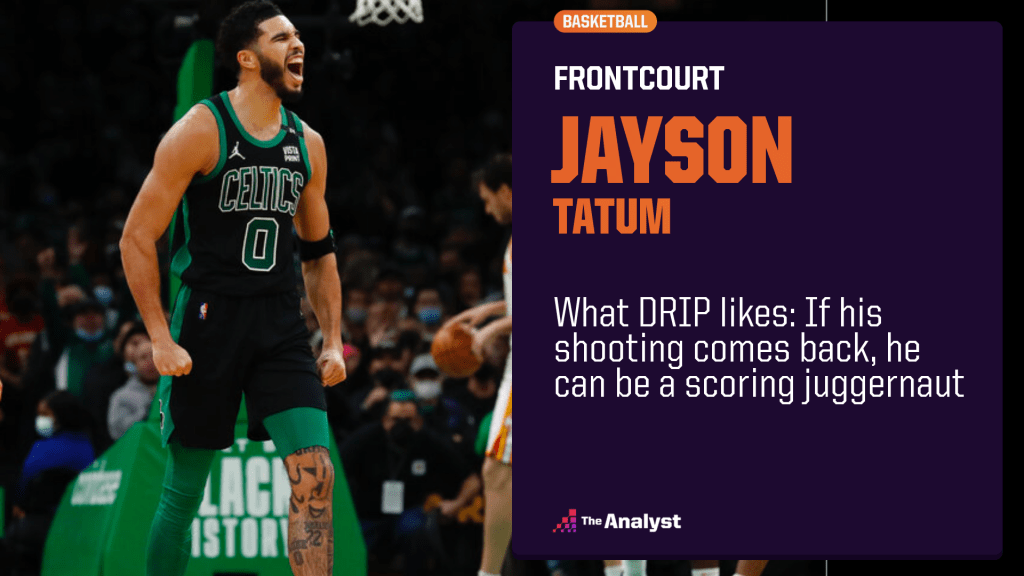
Jayson Tatum’s overall scoring numbers don’t look much different than last season. His scoring average is down 0.7 points per game despite taking the same number of shots. His assists are almost identical. So why is DRIP high on his offensive ability?
Well, if you look at Tatum’s shooting numbers, one thing stands out: His 3-point shooting has fallen off a cliff. He’s never shot worse than 37.3% on 3s for a season and he’s shooting 32.9% this year.
This may not seem like a good thing on the surface, but it’s unlikely that he continues to shoot this poorly. Tatum is still shooting 84.8% on free throws and it isn’t likely that he’s forgotten how to shoot at the age of 23.
DRIP projects Tatum to shoot 35.5% on 3-pointers, which is a modest regression that would still be worse than any season he’s had. And if he can hit or exceed that mark, he can live up to his billing as a top-10 offensive player by DRIP’s standards.
Tatum has managed to keep all his other numbers in line despite his poor shooting. He’s getting to the line more as well and has gotten a lot more looks within the flow of the offense during the recent great stretch for the Boston Celtics.
The jump shot is the only thing holding back his scoring potential. If that turns around, he’ll be one of the most lethal scorers in the game.
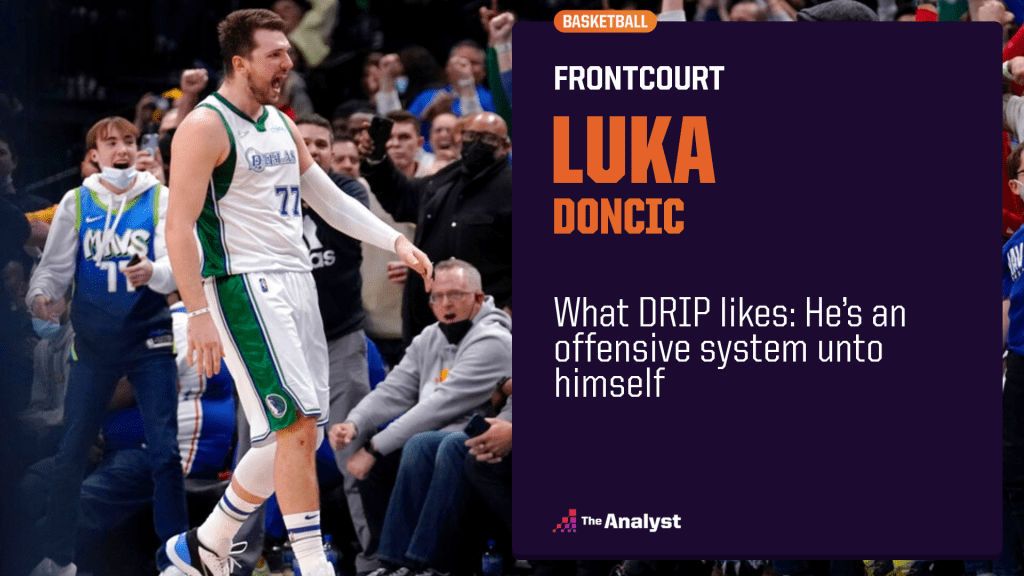
When Jason Kidd took over the Dallas Mavericks, there was a lot of talk about making the team less reliant on Luka Doncic offensively. But his usage percentage has actually gone up this year.
The Mavericks do have more options to handle the ball now that Jalen Brunson has emerged as a credible complement to Doncic, but it is still all about Luka. He projects to have the highest usage and score the most points, per DRIP. He is also projected to have the sixth-most assists per 100 possessions.
He started out the year somewhat slowly, but he’s still averaging video-game numbers at 27.2 points, 9.0 rebounds and 9.1 assists per game. And as he has rounded into form, so has his team.
Dallas is just 1.5 games back of Utah for home-court advantage in the first round. The Mavericks have a top-five defense so far and if they can keep being elite on that side of the ball without Kristaps Porzingis, you’d have to imagine that Doncic will get the offense to improve its current ranking (17th).
And if Doncic can be the offensive force DRIP projects him to be despite his high usage, the Mavericks will be a tough out in the playoffs.
Enjoy this? Subscribe to our mailing list to receive exclusive weekly content.
Graphic design by Matt Sisneros.
